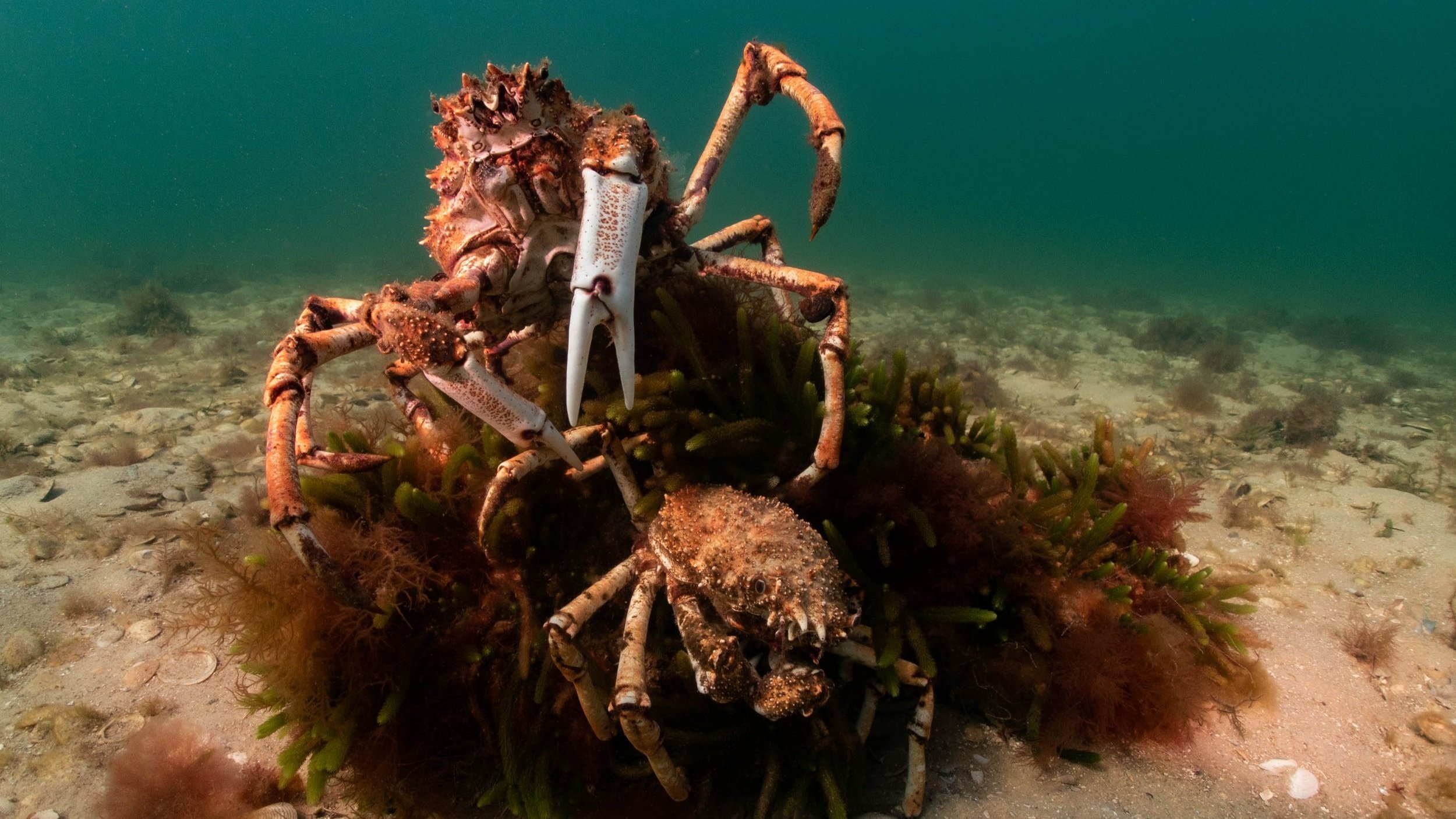SPIDER CRAB
A southern icon
Spider crabs are one of the most iconic and mysterious species of the Great Southern Reef. Like all crabs, giant spider crabs are arthropods (animals with jointed legs and a hard shell also called carapace). This species can grow as big as an average adult’s hand. They are found right throughout the Great Southern Reef.
Safety in numbers
In order to grow bigger, they need to extract themselves from their old shells (a process called moulting), expand their soft flesh and harden a new shell. This is the most vulnerable time of their lives as the process leaves them soft and stunned. To seek safety in numbers they get together in massive numbers and form what is called an “aggregation”.
Myriad mysteries
Aggregations are known to occur in Port Phillip Bay and in parts of the Tasmanian coast. Despite the fact that these aggregations attract local and tourists alike and have been featured in documentaries locally and internationally, scientists know very little about spider crabs. We are still trying to work out important questions such as:
- Where do the spider crabs hat form these aggregations come from and where do they go afterwards?
- How many spider crabs are there?
- What is the size and sex of the individuals during aggregations and does this vary between aggregations?
- What is the role of the aggregations in keeping the broader environment healthy, particularly the predators that hunt for soft crabs at this time of year?
Scientific studies
To solve spider crab mysteries, researchers at Deakin University are using a mix of traditional science and citizen science thanks to funding from the Victorian government.
This year for the first time, the Deakin research team deployed a range of methods to understand spider crabs and their aggregations in Port Phillip Bay better including:
- Sexing and measuring spider crabs in aggregations
- Performing underwater transects to estimate spider crab densities
- Deploying acoustic tags on spider crabs after they had moulted.
Listening stations are scattered around the coast and will allow us to sneak on spider crabs to know where they go after coming together en masse in the Bay. [learn more]
Understanding the aggregations
There just aren’t enough marine ecologists and resources around to keep an eye on spider crabs and really understand what they get up to, so we really need everyone’s help! Spider crabs are indeed distributed all along the Great Southern Reef and their aggregations can be short-lived and unpredictable!
So we’re calling out on all ocean lovers – divers, snorkelers, swimmers, anglers, boaters, etc – to let us know when and where they see spider crabs. So far, we expected spider crab aggregations to take place in Port Phillip Bay and Tasmania, but thanks to community members in South Australia who have reached out to the researchers, we know that aggregations happen there as well.
The more information we get, the more pieces of the puzzle we can put together to understand what kind of habitats is suitable for aggregations, how long aggregations last and what signals spider crabs might use to know that the right time and place to come together!
Logging a sighting is simple and only takes a few minutes. If you have got photos, even better, but sightings can be logged without them. When you come across spider crabs, alone or in aggregations, you can provide the date, time and location and answer a few questions at this link. Every sighting helps, and past encounters can be submitted as well if you’ve got information on past spider crab sightings.
Timelapse teamwork
Deakin’s research team has also deployed timelapse cameras and captured a lot of images of spider crabs and their predators during aggregations. Soon, they will need the help of the community to analyse these images, identify and count spider crabs and other species in their environment. Everyone will be able to participate from the comfort of their home, so stay tuned for more!
If you are interested in this research and would like to receive updates click here.
This article was written for the Great Southern Reef Foundation by Dr Elodie Camprasse of Deakin University. Imagery also provided by Elodie Camprasse.
Fast Facts:
Species: Leptomithrax gaimardii
Family: Majidae
Order: Decapoda (ten-footed crustaceans)
Feeding: Scavengers, eating a range of different types of food on or near the seafloor.
Habitat: Seaweed, Reef and Sand
Distribution: Endemic to GSR
Special Power: Mass moulting
Explore more of the Great Southern Reef
People
Impactful people with a close connection to the Great Southern Reef.
Places
Feature locations along the Great Southern Reef.
Marine Life
The weird and wonderful creatures found along the Great Southern Reef.










